
This is a list of sites in Minnesota which are included in the National Register of Historic Places. There are more than 1,700 properties and historic districts listed on the NRHP; each of Minnesota's 87 counties has at least 2 listings. Twenty-two sites are also National Historic Landmarks.

Little Bohemia, or Bohemian Town, is a historic neighborhood in Omaha, Nebraska. Starting in the 1880s, Czech immigrants settled in this highly concentrated area, also called "Praha" (Prague) or "Bohemian Town", bounded by South 10th Street on the east, South 16th Street on the west, Pierce Street on the north, and Martha Street on the south, with a commercial area went along South 13th and South 14th Streets, centered on William Street. It was located south of downtown, and directly west of Little Italy. A portion of the neighborhood along South 13th Street was listed on the National Register of Historic Places in 2020.
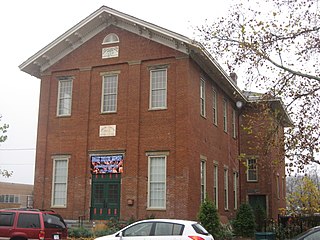
The Spencer Township Hall is a historic former government building in the Columbia-Tusculum neighborhood of Cincinnati, Ohio, United States. One of Cincinnati's oldest extant public buildings, it has been designated a historic site because of its architecture.

The Clearwater Masonic and Grand Army of the Republic Hall is a historic building in Clearwater, Minnesota, United States, constructed in 1888. It has served as a meeting hall for both a local Grand Army of the Republic (GAR) post, and a local Masonic Lodge, with commercial space on the ground floor. It was listed on the National Register of Historic Places in 1979 under the name Clearwater Masonic Lodge–Grand Army of the Republic Hall for having local significance in the themes of architecture and social history. It was nominated for its association with the fraternal organizations of Clearwater and many other rural Wright County communities that, in the words of historian John J. Hackett, "provided leadership, direction, and contributions to the county's political, educational, patriotic, and social life."
The Czech-Slovak Protective Society (CSPS), which became the Czecho Slovakian Association, was an organization supporting the welfare of Czech and Slovak immigrants to the United States. The Czech-Slovak Protective Society started as an insurance services organization. It was once the largest Czech-American freethought fraternity in the United States.
Bohemia Farm, also known as Milligan Hall, is a historic home located on the Bohemia River at Earleville, Cecil County, Maryland. It is a five bays wide, Flemish bond brick Georgian style home built about 1743. Attached is a frame, 19th century gambrel-roof wing. The house interior features elaborate decorative plasterwork of the Rococo style and the full "Chinese Chippendale" staircase. It was "part-time" home of Louis McLane.
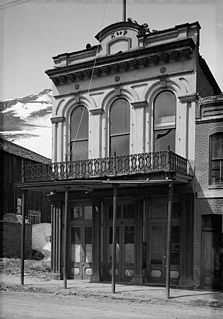
The Knights of Pythias Building, also known as the Knights of Pythias Hall is an historic Knights of Pythias lodge hall located in Virginia City, Nevada, United States. It was built of cast iron and stuccoed brick in 1876 by Nevada Lodge No. 1 of the Knights of Pythias, which had been formed on March 23, 1873. It was also used the city's other Knights of Pythias lodges: Lincoln Lodge No. 6 formed in 1874, and Triumph Lodge No. 11 formed in 1879. It is one of the few unaltered false-fronted buildings remaining in Virginia City. The Knights of Pythias Building is a contributing property in the Virginia City Historic District which was declared a National Historic Landmark in 1961 and added to the National Register of Historic Places in 1966.

Charles Sumner Post #25, Grand Army of the Republic is a historic fraternal lodge building located in Chestertown, Kent County, Maryland. Named after Charles Sumner, it was constructed as a meeting hall about 1908 and is a two-story gable-front frame building, built on brick piers, with a rectangular floor plan. It is located in the Scotts Point area, a historically black area within the Chestertown Historic District, and was abandoned between 1985 and 2002. It is one of only two Grand Army of the Republic halls for African-American veterans known to survive in the Nation.
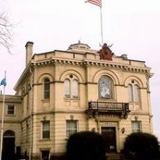
The B.P.O. Elks Lodge is a historic fraternal lodge building at 34 Prospect Street in Hartford, Connecticut. It is a Classical Revival architecture building designed by John J. Dwyer, and built in 1903 for the local chapter of the Benevolent and Protective Order of Elks. The building was listed on the National Register of Historic Places in 1984 for its architecture.

Yukon, Oklahoma's original Czech Hall was built in 1899 by early Czech settlers who were members of Sokol Karel Havliček Lodge and Western Fraternal Life Association Lodge Jan Žižka No. 67. That building was replaced by the current structure in 1925.
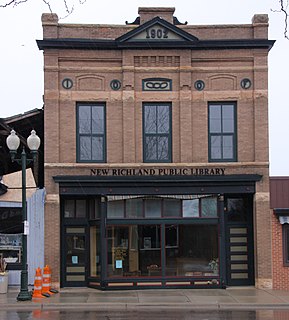
The New Richland Odd Fellows Hall is a historic Independent Order of Odd Fellows (IOOF) clubhouse in New Richland, Minnesota, United States, built in 1902. It was listed on the National Register of Historic Places in 2006 under the name Strangers Refuge Lodge Number 74, IOOF for its local significance in the themes of entertainment/recreation and social history. It was nominated for being the home of a large and important local fraternal organization, and for serving as a venue for a wide range of other groups and events. The building now houses the New Richland Public Library.

The Western Fraternal Life Association, previously known as Zapadni Ceska Bratrska Jednota is a fraternal benefit society and financial services organization in the United States. The association has its roots in the Czechoslovak immigrant community of the 19th century. It was once the second largest Czech-American freethought fraternity in the United States.
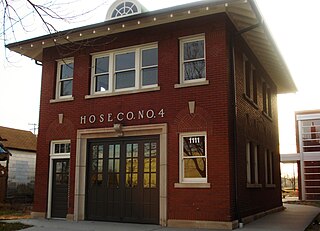
The Bohemian Commercial Historic District, also known as New Bohemia, is located in Cedar Rapids, Iowa, United States. It was listed on the National Register of Historic Places in 2002. At the time of its nomination it consisted of 75 resources, which included 48 contributing buildings, and 27 non-contributing buildings. Bohemian immigrants began settling in Cedar Rapids in the 1850s, and increasingly after the American Civil War in the 1860s and the Prussian War in Austria in 1880. They grew to be the largest ethnic group in the city, and the only one to settle in a distinct part of Cedar Rapids. They settled along the Cedar River between the downtown area and the T.M. Sinclair and Company meat packing plant. The buildings in the district were constructed between the 1880s and the 1930s. They are largely narrow-front commercial buildings and corner blocks. The buildings housed a variety of commercial establishments: a movie theater, two banks, and several filling stations. It also includes a railroad corridor factory building, a fire station, and fraternal halls. The buildings are representative of various commercial architectural styles and vernacular building forms popular at the times they were built. The Lesinger Block (1883) and the C.S.P.S. Hall (1891) are individually listed on the National Register of Historic Places.

The Western Bohemian Fraternal Union Hall is a historic clubhouse in Meadowlands Township, Minnesota, United States. It was built in 1925 as a meeting hall for a lodge of the Western Bohemian Fraternal Union, a society of Czech Americans. The hall also served as a host for Sokol gymnastics events. The hall was listed on the National Register of Historic Places in 1986 for its local significance in the themes of European ethnic heritage and social history. It was nominated for being a long-serving rural venue for the preservation of Czech American culture and heritage.
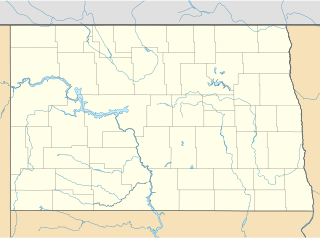
The Mizpah Lodge Building on Front St. in Sheldon, North Dakota was built in 1905. It has also been known as Mel's Country Grocery. It is a fraternal/commercial block building. It was listed on the National Register of Historic Places in 2005.
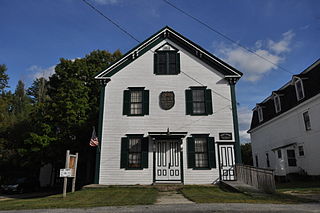
The West Paris Lodge No. 15, I.O.O.F. is a historic fraternal clubhouse at 221 Main Street in West Paris, Maine. It was built during 1876-80 by the local chapter of the International Order of Odd Fellows (IOOF), and served as the meeting place for the fraternal organization into the 1980s. It is also a significant meeting space for social events in the wider community. The building, now owned by the local historical society, was listed on the National Register of Historic Places in 2012.

The Saratoga Masonic Hall is a two-story brick building in downtown Saratoga, Wyoming that houses Saratoga's Masonic lodge. Established in 1892, the lodge was the fourteenth to be established in Wyoming. After a time in rented space, the lodge bought the Couzens and Company Block in 1893, using the second floor for meetings and leasing the ground floor to storekeeper A. Johnson Dogget. From 1895 the ground floor was used as a school. The Masons allowed a variety of other organizations to use the building, including the Odd Fellows, Knights of Pythias, Pythian Sisters, Union Fraternal League, Modern Woodmen, Women of Woodcraft, Job's Daughters, the Republican Party and the Ku Klux Klan.

Ironton Lodge Hall, also known as Star of the West Lodge, No. 133,A. F. & A. M. Building; and Iron Lodge No. 107. I.O.O.F., is a historic lodge hall located at Ironton, Iron County, Missouri. It was built in 1873, and is a three-story, rectangular brick building with Italianate and Greek Revival style design elements. It measures 29 feet by 57 feet. It was built to serve primarily as a meeting place for fraternal lodges.

The Lesinger Block, also known as Little Bohemia, is a historic building located in Cedar Rapids, Iowa, United States. This building was constructed at a time of economic expansion in the city. It is a contemporary of several Italianate commercial blocks that were built downtown. Because of subsequent development in that commercial district those buildings have been replaced with newer structures leaving this building as the best extant example of commercial Italianate in Cedar Rapids. It was constructed by Vaclav Lesinger, an immigrant from Kozlov, Bohemia. He was a tailor by trade and he had this structure built in 1883 to house his tailor shop and a dry goods store. Since 1907 the building has housed a tavern that has served as a social center for the local Bohemian community. Architecturally, the two-story brick structure still retains a good deal of its original wood ornamentation, including the sawtooth frieze above the storefronts and the geometric design in the bracketed cornice.
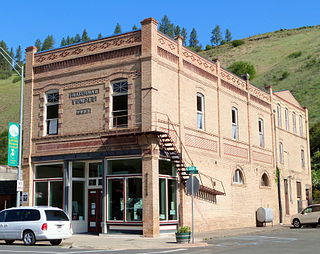
The Kendrick Fraternal Temple, at 614 E. Main in Kendrick, Idaho, was built in 1905. It was listed on the National Register of Historic Places in 2013.




















